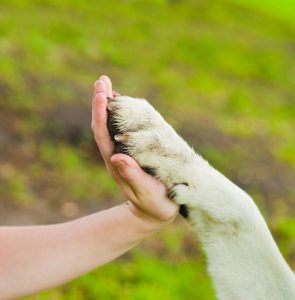It is often believed that the only thing you can do to help your ailing pet is to take it to the vet and deal with the stress, fear, and large bills that come along with it. However, this does not always have to be the case. While you should always take your pet to the vet at any sign of trouble, it is also good to know that there are treatment plans available for your pet to help ease their pain and discomfort in a much more natural, soothing manner. These options include chiropractic treatment for pets, reflexology, and massage. All three of these options aim to increase the comfort and well-being of your pet, but they each have very different methods of doing so. Some of these options can be performed at home, but it is important to note that there are experienced professionals right here in Las Cruces that can assist you in improving your dog’s life. Information about those professionals and an upcoming health fair will be listed at the end of this article.
Chiropractic Treatment for Pets
Of the three techniques we will be discussing in this post, chiropractic treatment for pets is the one that you absolutely need a professional to do for you. An inexperienced person practicing chiropractic treatment can cause serious harm to your pet due to the precise nature of adjusting the spine. Do not try this one at home. That being said, chiropractic care is one of the most powerful types of natural treatments for both pets and humans. This is because chiropractors focus on realigning and adjusting the neck and spine, which corrects a multitude of problems and proves to be an excellent form of long-term therapy to keep the body as healthy and comfortable as possible.
Chiropractic treatment for pets can help alleviate problems such as hip dysplasia, weak legs, stiffness, hunched back, pain in the chest, back, or neck, and osteoarthritis. If your pet appears to be in pain, take them to the vet for a diagnosis before anything else. When you and your pet meet with a chiropractor, they will first evaluate your pet to see exactly what kind of help they need. They do this by looking at the pet’s history, vet records, and x-rays. With all of this information in mind, they will know that to look for when beginning the treatment, and will proceed to learn even more about your pet’s problem once they begin a hands-on adjustment.
There are many ways adjusting your pet, and each chiropractor will have their on technique. Dr. Randy Kidd explains, “The way I was taught, a chiropractic adjustment consists of the following. First, identify the specific site of the subluxation and identify the direction the joint is ‘stuck’ or ‘loose.’ The contact point (the bony part of the anatomy where the adjustment will be performed) is located, and the adjuster creates a firm contact with the underlying bone, and the patient’s body is stabilized. Then, the actual adjustment is performed by moving the hand…in the direction that is specific for the way that the joint needs to be returned to normal function.” These adjustments are mostly done with just the chiropractor’s fingertips or by using a small device called an “activator” which gently presses the bones back into place. Adjustments for dogs are quite different from adjustments for humans since dogs are much more delicate creatures that only require a gentle touch.
One trip to the chiropractor will not immediately fix the pet’s problem, but it should quickly alleviate the pain or discomfort that they may be feeling. Your chiropractor will work out a schedule with you and discuss how often your pet should be adjusted. This can be as often as twice a week, or as few as once every couple of months.
Reflexology Aides Your Pet
Reflexology is a very different form of treatment than chiropractic care. While chiropractic care treats the immediate cause of your pets discomfort, reflexology aides your pet by relaxing them, increasing their blood circulation, and by promoting balance in your pet’s system which can increase healing time.
Reflexology is performed by pressing firmly on the pads of your pet’s feet and ankles, using gentle pressure and specific circular movements to promote blood circulation and to help clear blockages in your pet’s system caused by stress or toxins. In his article, Andrew Jonasson notes that, “Toxins get into your dog by way of his food. Most commercial pet foods contain preservatives, sugar, and other additives like coloring. These foods can lead to chronic health issues like diabetes, allergies, and kidney failure…reflexology is important to cleanse your dog’s body of wastes and detoxify his organs.”
It is also believed that stress in your pet’s daily life can affect their inner workings, causing inflammation and tensed muscles throughout the body. Pets can sense when their owners are stressed and will imitate the behavior they see. This can cause long-term damage to their internal system. Reflexology aides your pet by allowing them a few moments to relax, soothe their tensed muscles, and possibly even reduce some inflammation caused by stress.
While this is something you can attempt at home, it really takes a professional eye to determine where the reflexology points are on your pet, and how they correspond to their organs and to the different parts of your pet’s body. Done incorrectly, it will result in a simple foot massage that your pet may still find relaxing. Done correctly, however, a professional can help flush your pet of toxins, improve their circulation, and disperse pain in tensed muscles throughout the body.
Massage
Massage is similar to reflexology in that it is a form of treatment that can help relax a nervous pet, helps relieve muscle tension, and improve blood circulation. It also aides in digestion, provides greater joint flexibility, stimulates liver and kidney function, and strengthens the immune system. Massage is an excellent form of treatment for any pet, of any age, whether they have health issues or not. Regular massage sessions can help keep your pet in tip-top shape for as long as possible.
Kristina Lotz explains that, “there are a few cases where massage can be particularly helpful. Reducing stiffness and fatigue after exercise by increasing circulation and flushing waste products from the muscle tissue. Massage can be great for both before and after exercise. Invigorating massage (quick strokes) can be great for dogs that are about to compete in agility competitions or for older dogs that are stiff and about to go out for a walk in the neighborhood.” You can also use slow, relaxing strokes for older pets, pets suffering from anxiety, or energetic young pets. Massage is an excellent form of treatment for any pet, but each pet will need a different form of massage due to the varying issues they may have.
Because there are so many different ways to massage your pet and because different techniques are used for different symptoms, it is crucial to go slow and to not attempt to massage your pet like you would a human. This method is often too rough for pets and can cause more harm than good. To avoid any potential damage and to learn good techniques, you may chose to take your pet to a professional animal massage therapist to do the hard work for you.
Your Pet Space Health Days
Because all of these treatment options are so important and can provide your pet with some real health benefits, Your Pet Space will be having a health fair from February 23-25, 2017 from 12:00 to 7:00 p.m by appointment. There will be doctors and technicians performing reflexology, massage, chiropractic treatment, and reiki, as well as classes discussing essential oils, flower essences, and more. These events will provide you with even more information about the importance of chiropractic care for pets, reflexology, and massage, so it is really something that you can’t miss. If you are interested in any of these classes and treatments or for more information, please call Your Pet Space at 575-652-4404 to schedule an appointment.
Jessica Smith, Associate Editor, having been raised in a household full of dogs, guinea pigs, hamsters, and all things furry, Jessica’s love of animals has only grown over the years. She is currently volunteering for Safe Haven Animal Sanctuary in her free time when she isn’t out and about with her ridiculous pit bull mix, Annabel Lee, or taking care of her remarkably ancient guinea pig, Moose. She is also putting her literature degree to use by working as an editor for a local online magazine, Independent Noise. While she has no plans for the future, she knows that it will be filled with fur and fiction galore. You can e-mail Jessica at associateeditorjessica@yourpetspace.info







